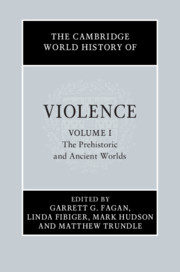Book contents
- The Cambridge World History of Violence
- The Cambridge History of Violence
- The Cambridge World History of Violence
- Copyright page
- Contents
- Figures
- Maps
- Contributors to Volume i
- General Introduction: Violence in World History
- Introduction to Volume I
- Part I The Origins of Conflict
- Part II Prehistoric and Ancient Warfare
- Part III Intimate and Collective Violence
- 14 Early Massacres: Mass Violence in Neolithic Europe
- 15 Gendered Violence in Iron Age and Roman Britain
- 16 Violence in Ancient Egyptian Society
- 17 Violence and the Mutilated Body in Achaemenid Iran
- 18 ‘Knocking Her Teeth out with a Stone’: Violence against Women in Ancient Greece
- 19 Gang Violence in the Late Roman Republic
- 20 Violence in Early Chinese History
- Part IV Religion, Ritual and Violence
- Part V Violence, Crime and the State
- Part VI Representations and Constructions of Violence
- Index
- References
15 - Gendered Violence in Iron Age and Roman Britain
from Part III - Intimate and Collective Violence
Published online by Cambridge University Press: 13 March 2020
- The Cambridge World History of Violence
- The Cambridge History of Violence
- The Cambridge World History of Violence
- Copyright page
- Contents
- Figures
- Maps
- Contributors to Volume i
- General Introduction: Violence in World History
- Introduction to Volume I
- Part I The Origins of Conflict
- Part II Prehistoric and Ancient Warfare
- Part III Intimate and Collective Violence
- 14 Early Massacres: Mass Violence in Neolithic Europe
- 15 Gendered Violence in Iron Age and Roman Britain
- 16 Violence in Ancient Egyptian Society
- 17 Violence and the Mutilated Body in Achaemenid Iran
- 18 ‘Knocking Her Teeth out with a Stone’: Violence against Women in Ancient Greece
- 19 Gang Violence in the Late Roman Republic
- 20 Violence in Early Chinese History
- Part IV Religion, Ritual and Violence
- Part V Violence, Crime and the State
- Part VI Representations and Constructions of Violence
- Index
- References
Summary
This chapter employs the ‘mindful body’ and ‘web of violence’ models to survey the range of violence present in Britain during the Iron Age and Roman periods (ninth century BCE – fifth century CE). By recognising that in a community all forms of violence are interrelated and frequently share many causative factors, these models allow for indirect forms to be included (e.g. health inequalities). Iron Age Britain was inhabited by tribal communities, and the results are dominated by young adult males, who have the majority of the evidence for organised conflict, reflecting the presence of a warrior elite. Females and children show evidence for performative violence, with their bodies being broken down and transformed in complex rituals. Bioarchaeological data suggests an absence of evidence for abuse against children, older people and women. After the Roman conquest of 43 CE the evidence for age-, sex- and status-based inequalities substantially increases, and these are much more clearly defined and observable in the primary source and bioarchaeological evidence, particularly enslavement. Overall, health declines, and evidence for the abuse of vulnerable groups increases, principally in females. Ritual violence continues and is attested in deposits of disarticulated body parts associated with sacred spaces, including cemeteries.
- Type
- Chapter
- Information
- The Cambridge World History of Violence , pp. 320 - 341Publisher: Cambridge University PressPrint publication year: 2020
References
Bibliographic Essay
- 1
- Cited by



